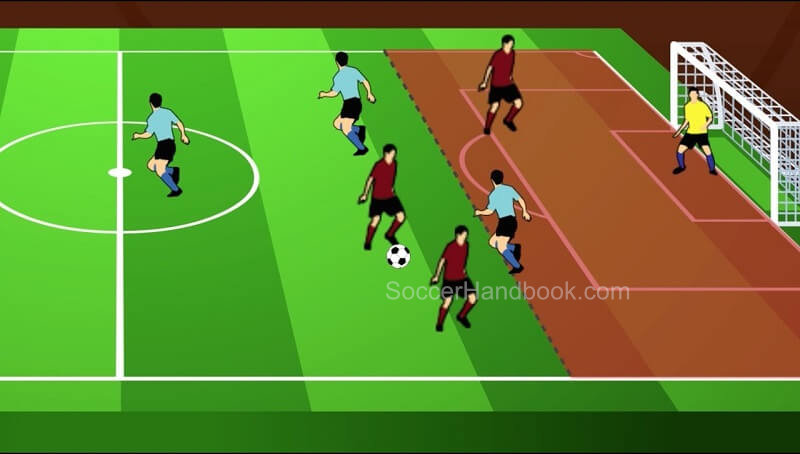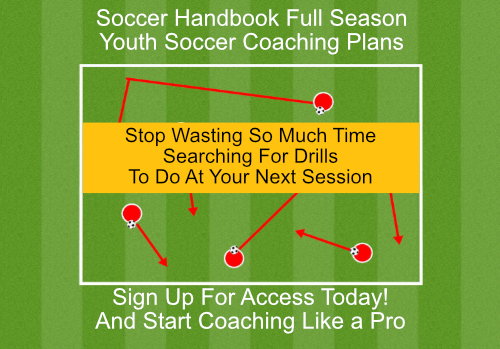What is Offside in Soccer? An Explanation of the Soccer Rule
Offside is generally assumed to be one of the most confusing parts of soccer. Everyone from Ted Lasso to new Wrexham owner Ryan Reynolds has joked about how complicated the rules are. Sometimes, even the players and coaches themselves don’t understand how it works!
However, the laws of the game are very important. It prevents attacking players from having an unfair advantage of hanging around the goal, waiting for easy chances. Understanding offside rules can be a valuable asset for both attackers and defenders.
What is Offside in Soccer?
The simplest definition of offside: When the ball is passed, the receiving player must have at least two players from the opposing team between them and the goal. If the receiving player is past the last defender (referring to the last field player, not the goalkeeper) when they receive the ball, they are offside.
The rule is based on the number of players defending the goal, regardless of their named position.
The focus of the offense is always where the receiving player is when the ball is passed. If a player is in an offside position when the ball is passed, it doesn’t matter if they return to an onside position when the ball is received. The moment the ball leaves the passing player’s foot, the receiving teammate needs to be onside.
This also means that once the ball is passed, the receiving player can receive the pass anywhere on the field. For example, the receiving player can start in their half but receive the ball in the opponent’s half. This often creates dangerous scoring opportunities. This makes timing your run all the more important.

When Are You Offside in Soccer?
There are many different ways and times a player can be offside. However, all of the following need to occur:
The Attacking Player Needs to be in the Opponent’s Half.
A player can not be offside in their own half. The rule only applies in the opponent’s half. This is why strikers often wait around the middle of the field when their team is defending.
The players will be onside as long as they stay in their own half, regardless of the location of the opponent’s defense.
The Attacking Player Needs to Be Actively Involved in the Play.
A player can stand in an offside position as long as it is not involved with active play, although this is not recommended. If a player interferes with the opponents, such as blocking the opponent’s line of vision or making an attempt for the ball, then this is offside, even if they don’t touch the ball.
The Attacking Player Needs to Be Past the Second-to-Last Defender.
The attacking player must be past the second-to-last defender to be offside. This includes any part of their body except their hands and arms.
If a striker looks up and sees no one between them and the goalkeeper when the pass is played, they are offside. If there is a defender there, then they are probably onside.
There is often a lot of confusion with the rule because people often say players “can’t be past the last defender.” They forget that the rule really means there must be two opposing players between you and the goal when you don’t have the ball. They forget that, technically, the Goalie is a defensive player.
The Attacking Player Needs to be in Front of the Ball.
Players can only be offside when they receive a forward pass, even if they are past the last defender. If they are level with or even behind the ball when it is passed to them, they are onside. This is one of the reasons crosses are so effective, as they typically require the crossing player to be in front of the receiving player.
Loopholes
There are certain exceptions to the offside rules.
Offside Doesn’t Apply During Throw-ins.
Players can receive the ball from anywhere on the field from a throw-in. Because of this, some teams focus on earning throw-ins in the opponent’s half and then launching them toward the goal to give their attackers good opportunities.
Corner Kicks Also Don’t Have Offsides for a Very Simple Reason.
As mentioned earlier, the attacking player needs to be in front of the ball for it to be called. Corner kicks occur on the edge of the field, so attacking players can’t be offside when the corner is initially taken. However, once the ball is in play, the usual rules apply.
For example, a common error can occur on short corner kicks. When players receive the ball and pass it back to the corner taker, who hasn’t moved yet, they are offside.
If the Player Receives the Ball From the Opponent, Then They Are Not Offside.
If the opponent intentionally plays the ball, such as heading or passing it, and sends it to an attacking player in an offside position, then the attacking player is not offside. Additionally, if the opponent tries to play the ball and deflects it to the attacker, then the attacker is not offside.
Players Can Not Be Offside On a Goal Kick
One of the little-known loopholes in the Offside Rule is that you can’t be offside on a goal kick. If you have a goalie who can kick the ball the full length of the field, the forwards can stand alone in their opponent’s end.
There is a catch, though: The forward must receive the ball directly from the goal kick. If another player touches the ball in any way, the player is not onside.
The Goalkeeper is Considered a Defender
The strangest part of the offside rules has to do with the goalkeeper. As mentioned earlier, the attacking player must be behind the second-to-last defender to be onside.
Again, the confusion here is because most people think the offside rule identifies defenders. But it really means opposing team players. It doesn’t matter if that is a goalie and a defender or two defenders. The two players could even be midfielders or forwards.
If the attacking player is past the goalkeeper, there must be two last defenders instead of just one. This also means the goalie is likely out of position, which is another issue.
This rarely occurs, but it occasionally does. One notable time that it happened was in the 2022 Champions League Final, where it resulted in Karim Benzema’s opener being called off.

Modern Offside Rules & Technology
The recent introduction of Video Assistant Referee, better known as VAR, into many leagues has been controversial. It often results in conflicting calls and opinions on whether or not a player is offside.
Despite the controversy, VAR and other offside technologies have helped more than they have hurt, even in lesser-known ways. For example, prior to this technology, the linesman (the referee on the side of the field) would have to make the call in real-time, resulting in a lot of incorrect calls.
Players who would be onside could have been incorrectly called offside, resulting in a great chance being wasted. Now, thanks to VAR, referees are encouraged to let play continue. Knowing that they can go back and check the play if needed. Although this delay can be frustrating for players and fans.
Thanks to advanced technology, they can now wait and let the play unfold before checking to see if there is an infraction. Some technology even creates a 3D model, as was used in the 2022 World Cup. As technology continues to develop, expect to see more and more leagues take advantage of these devices and technology.
How Can I Benefit From Knowing the Offside Rules
Both attackers and defenders can benefit and improve their game by understanding offside rules.
Defenders can intentionally move to put the attacking players in offside positions, better known as an offside trap. Just before the ball is passed to the receiving player, the defenders will step up, leaving the receiving player behind the defensive line. This can limit opportunities and frustrate the attacking side.
For attackers, knowing the rules can help with staying onside. For example, understanding the rules about deflections and involvement in the play can let an attacker know when they should and should not play the ball.
They can also learn to time their runs better and beat offside traps, resulting in great chances. Some of the best players in the world are successful because they know how to time their passes and runs to unlock the defense and gain an advantage.
In some instances, goalkeepers can also benefit from knowing when a player is onside or offside. This knowledge can help them better organize their defense or know when or when not to challenge the ball. It can prevent a situation where they risk deflecting a ball to an offside opponent, making a possible goal legal.
What Happens After an Offside Call?
When an attacking player is offside, the linesman raises the flag to signal the call. The other team is given an indirect free kick from the spot of the violation, and the play restarts. There is no further punishment for this infringement, meaning they do not receive a yellow card.
If an offside is given and the player chooses to play on, then a yellow card may be given as the player is delaying the game. Kicking the ball away after a call can also result in a yellow card.
If the referee goes to VAR or consults the linesman and determines there was an infringement that he missed, he can go back and call offside. Anything that happened during a play that was changed is then removed, meaning that an offside call can rule out goals, penalties, or even yellow and red cards.
Final Thoughts
They might be a bit confusing at first, but once you understand the offside rules, it helps players, coaches, and fans alike see the game in a completely different light. The best player is intelligent, and a smart player can understand and take advantage of the rules.






